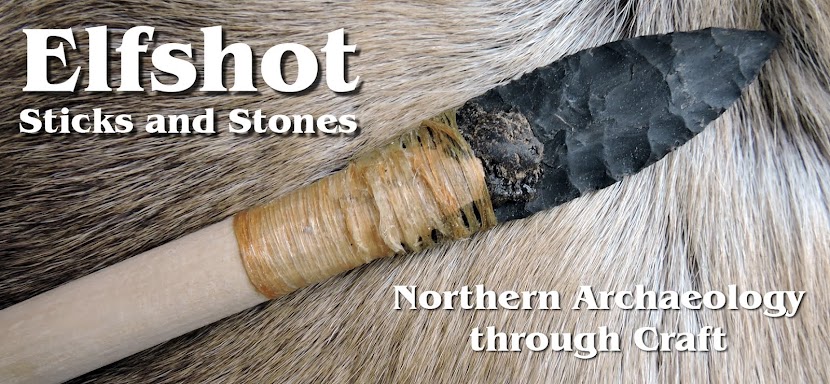 |
| A new Nephrite endblade |
A reproduction that is intended for hands-on use can expect a certain amount of wear and tear over its lifetime. A few nicks and scratches can help antique a piece, but sometimes the damage is a little more severe and repairs are required. Recently, I had a chance to revisit a harpoon that I made a few years ago that suffered some heavy usewear during the filming of
The People of NunatuKavut.
 |
| Still from the trailer for The People of NunatuKavut. There's the harpoon. In this scene its playing the part of an harpoon being repaired. Its been cast in the same role in this blog post Typecast? |
 |
New nephrite endblade, ivory finger
rest and whalebone foreshaft. |
I can sympathize with the owner of the harpoon - it sucks when something breaks, but from a purely selfish perspective I do enjoy the opportunity to make minor repairs to the tools and see how they are aging through use. Usually when I make a reproduction, I make the whole thing from scratch, all at once. While I'm sure that happened on occasion in the past, I think that a lot of tools were repaired, resharpened and had replacement pieces made bit-by-bit over their lifetime. I think that is one of the reasons that there is so much conservatism in archaeological artifacts within a particular culture over time. A single complex tool might have many identical replacement pieces made for it over its lifetime.
 |
| The repaired harpoon. Good as new. |
 |
The old foreshaft had
the tip broken off and glued back on. |
This particular harpoon had a broken foreshaft and a missing endblade and finger rest. The new foreshaft needed to fit into the existing socket and harpoon head and the lashing holes needed to match the holes on the harpoon mainshaft, so by necessity it was going to be very similar to the original, broken foreshaft. The same is true for the endblade and finger rest. There are some minor differences between the new nephrite endblade and ivory finger rest and the original components made from the same material, but in the hafting area they are going to be identical.
 |
| Nephrite is a beautiful and tough stone |
If you imagine this same sort of wear-and-tear over the entire lifetime of the harpoon, there are going to be many identical pieces produced as old pieces wear out, get broken or are lost. If this same harpoon is used and repaired repeatedly in the same location its archaeological footprint is going to be magnified. Two foreshafts don't necessarily represent two harpoons, they may represent one well-used and repaired tool. The same way that a single person or family can have a big impact on a landscape over a lifetime, a single tool can leave a big imprint in the archaeological record as it is curated, repaired, and re-used. I think this is especially true of the stone components of a tool. The organic handles and sockets that are less likely to preserve are the pieces that are more likely to be curated and stay with the user over time. By comparison, the stone blades are disposable and many new blades might be fit into a well-loved handle over its lifetime.
 |
| The finger rest inserted back into its slot and re-lashed with two strips of baleen. |
Photo Credits:
1, 3-7: Tim Rast
2: Screen capture from
The People of NunatuKavut trailer.








No comments:
Post a Comment